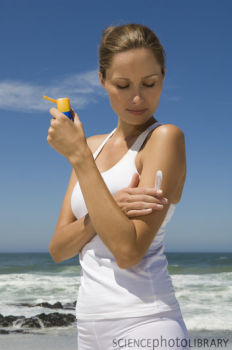美国研究人员发现,皮肤中含有感光物质,能够甄别太阳光线中的有害紫外线,启动防御机制,而涂抹防晒霜可能有碍皮肤这种自我防御功能。
布朗大学细胞生物学家埃琳娜·万恰认为,皮肤就像眼睛一样能够“看见”光线。为验证这一想法是否正确,她带领研究人员,用不同波长的光线照射人的皮肤,记录皮肤反应。
结果发现,皮肤与眼睛视网膜一样,含有感光物质“视紫红质”。这种物质在蓝光和紫外线照射下最为活跃,刺激皮肤在数秒内生成黑色素,吸收有害紫外线,防止形成恶性黑色素瘤和其他皮肤癌。
先前观点认为,皮肤在日晒数天后生成黑色素,皮肤变黑。
英国《每日邮报》4日援引万恰的话报道:“我们发现,人体皮肤用一种类似视网膜使用的机制甄别光线,反应时间显著快于先前所知。”
这一研究结果由最新一期《当代生物学》杂志发表。
“先前没有证据表明感光物质在皮肤中也发挥作用,”万恰说,“我们的研究显示,专门的紫外线感光物质使得皮肤细胞能够迅速甄别紫外线,并作出反应。”
她说:“眼睛和皮肤这两样时常曝露在太阳光线下的器官组织,用类似的分子机制适应光线。”
万恰计划继续研究皮肤中感光物质的作用机制。她说:“这只是冰山一角,因为在分子层面仍有许多东西需要弄清。”
万恰说,在开发和使用广谱防晒剂时应当考虑皮肤的这种自我保护能力。她认为,防晒霜不必追求完全隔离太阳光线,因为这样会阻挡某些波长的光线启动身体自我防御。
研究人员希望这项结果能够帮助制药企业开发更有效的产品。
防晒霜的作用原理是将皮肤与紫外线隔离开来,分为物理防晒和化学防晒。物理防晒霜在脸上涂开后,形成保护膜,像镜子一样反射阳光,达到防晒目的。典型的物理性防晒成分呈白色糊状,必须使用卸妆产品帮助卸除干净。
化学防晒霜则利用吸收的原理来防晒,常为透光物质,可吸收紫外线,防止阳光接触皮肤。理论上讲,物理防晒优于化学防晒,但目前市面上大多使用化学防晒。(生物探索)
相关英文论文摘要:
UVA Phototransduction Drives Early Melanin Synthesis in Human Melanocytes
Exposure of human skin to solar ultraviolet radiation (UVR), a powerful carcinogen comprising ∼95% ultraviolet A (UVA) and ∼5% ultraviolet B (UVB) at the Earth's surface, promotes melanin synthesis in epidermal melanocytes , which protects skin from DNA damage . UVB causes DNA lesions [6] that lead to transcriptional activation of melanin-producing enzymes, resulting in delayed skin pigmentation within days . In contrast, UVA causes primarily oxidative damage [8] and leads to immediate pigment darkening (IPD) within minutes, via an unknown mechanism. No receptor protein directly mediating phototransduction in skin has been identified. Here we demonstrate that exposure of primary human epidermal melanocytes (HEMs) to UVA causes calcium mobilization and early melanin synthesis. Calcium responses were abolished by treatment with G protein or phospholipase C (PLC) inhibitors or by depletion of intracellular calcium stores. We show that the visual photopigment rhodopsin is expressed in HEMs and contributes to UVR phototransduction. Upon UVR exposure, significant melanin production was measured within one hour; cellular melanin continued to increase in a retinal- and calcium-dependent manner up to 5-fold after 24 hr. Our findings identify a novel UVA-sensitive signaling pathway in melanocytes that leads to calcium mobilization and melanin synthesis and may underlie the mechanism of IPD in human skin.
英文论文链接:https://www.cell.com/current-biology/abstract/S0960-9822(11)01086-4








